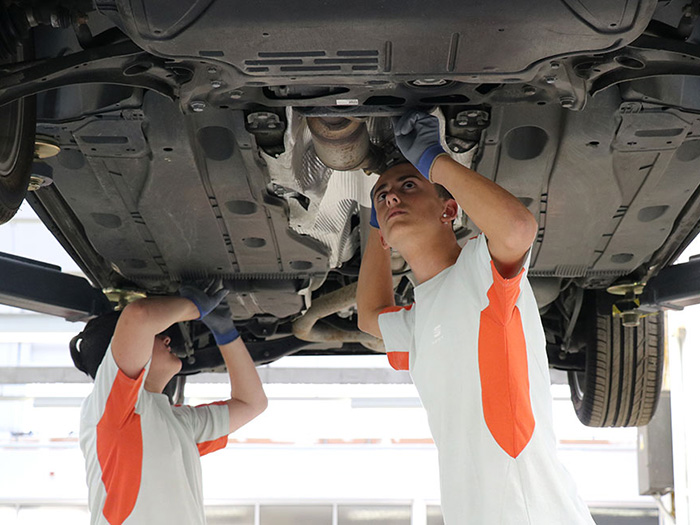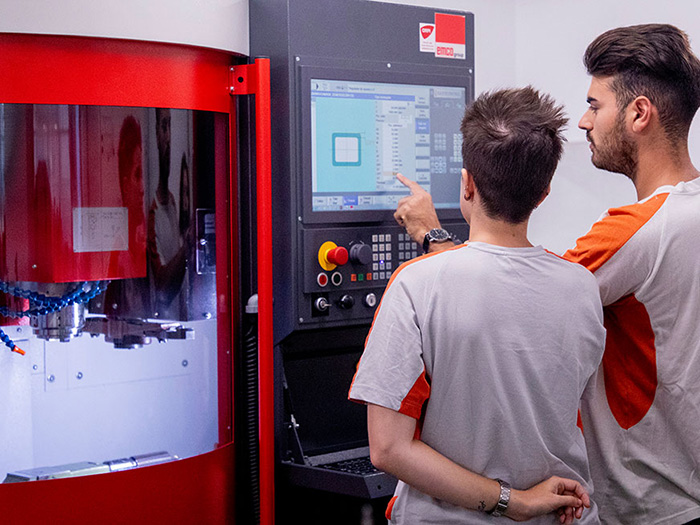Dual Training, the winning formula of the SEAT Apprentice School
From the first technical courses to the current advanced degrees in Automation and Industrial Robotics, the SEAT training centre has been preparing automotive professionals for over sixty years.
“Tell me and I'll forget; teach me and I'll remember; involve me and I'll learn”. This is the motto you can read over the entrance door to the workshop in the SEAT Apprentice School. An institution founded 62 years ago to provide courses of a purely technical nature, which has trained more than 2,800 students in its history.
Now it is a Dual Training system, with more than 5,000 theoretical and practical class hours per student. The SEAT Apprentice School was a project that was created with the Zona Franca factory in Barcelona in the 50s, to work with the best professionals, trained on site. Since then more than 15 million hours of training have been provided.
The pioneers

The first 18 apprentices left the school in 1960 and began work directly at the factory: a story of quality training and job stability that continues today. “SEAT has been with me throughout almost my entire life”, Xavier Méndez, who enrolled in the School in 1963.“From apprentice to factory worker and from factory worker to Head of Maintenance in the Bodywork area of the Martorell factory”.
Antonio Molina, ex-student and SEAT employee, recalls that in the 70s “there wasn't a single car in the workshop because we were trained in facility maintenance. The School has been anticipating the needs of the car industry and has learned to adapt”.
The Dual Training system

Today, the Martorell plant has become the place where most activities take place. “Several years ago, practical work was only carried out in the School's workshop, but today's students have access to the factory right from their first year,” explains Alberto Martínez, who completed his studies in 2016.
The Dual Training system, which combines theoretical and practical classes, was introduced in 2012, and allows students to obtain a degree valid both in Spain and in Germany. At the end of their first term as an apprentice, they can start working in the factory and get paid for it.
A woman's world, too

The first female student entered the facility in 1971, beginning a tradition which led the SEAT Apprentice School to have twice as many women as other similar schools in the sector.
Marisa Dameá, who is studying an advanced degree in Automation and Industrial Robotics, has always wanted to work in robotics and programming: “I can see myself working in the Technical Centre or in the factory with the robots.”
A contract on the horizon

Students who successfully complete their training cycle are hired by SEAT with an open-ended contract. Over the past six decades, 2,542 graduates have been rewarded this way. “Every term at the School is an opportunity for young people to further their talent by training them with the best tools to tackle their working future. Having the right skills and a commitment to continuous learning will be the stand-out factor for both their career and the industry itself,” according to Laura Carnicero, who is the head of Training at SEAT. In fact, 11% of all SEAT executives are graduates of the Apprentice School.
“At SEAT we know that there will be professions in the future that haven't been invented yet. Our people must be ready for them.” This is why students at the school study different programming languages and even have access to a small smart factory so they can learn and practice the most futuristic technologies.
The evolution continues
A new term has begun in September, with 74 students who are going to specialise in four advanced degrees. “Everything is changing and evolving very quickly, so we have to give the students cutting-edge learning tools, as what they assimilate today is a good foundation for the future, but not enough. They must continue to learn for the rest of their lives,” concludes Laura Carnicero.
Source: SEAT S.A.
